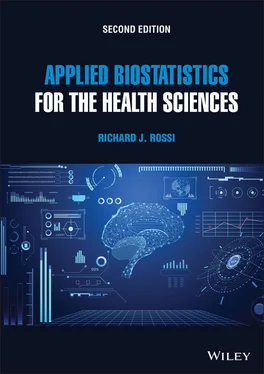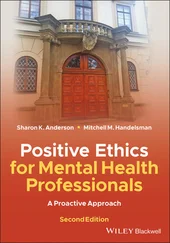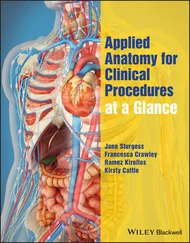Richard J. Rossi - Applied Biostatistics for the Health Sciences
Здесь есть возможность читать онлайн «Richard J. Rossi - Applied Biostatistics for the Health Sciences» — ознакомительный отрывок электронной книги совершенно бесплатно, а после прочтения отрывка купить полную версию. В некоторых случаях можно слушать аудио, скачать через торрент в формате fb2 и присутствует краткое содержание. Жанр: unrecognised, на английском языке. Описание произведения, (предисловие) а так же отзывы посетителей доступны на портале библиотеки ЛибКат.
- Название:Applied Biostatistics for the Health Sciences
- Автор:
- Жанр:
- Год:неизвестен
- ISBN:нет данных
- Рейтинг книги:3 / 5. Голосов: 1
-
Избранное:Добавить в избранное
- Отзывы:
-
Ваша оценка:
- 60
- 1
- 2
- 3
- 4
- 5
Applied Biostatistics for the Health Sciences: краткое содержание, описание и аннотация
Предлагаем к чтению аннотацию, описание, краткое содержание или предисловие (зависит от того, что написал сам автор книги «Applied Biostatistics for the Health Sciences»). Если вы не нашли необходимую информацию о книге — напишите в комментариях, мы постараемся отыскать её.
APPLIED BIOSTATISTICS FOR THE HEALTH SCIENCES Applied Biostatistics for the Health Sciences
Applied Biostatistics for the Health Sciences
Applied Biostatistics for the Health Sciences — читать онлайн ознакомительный отрывок
Ниже представлен текст книги, разбитый по страницам. Система сохранения места последней прочитанной страницы, позволяет с удобством читать онлайн бесплатно книгу «Applied Biostatistics for the Health Sciences», без необходимости каждый раз заново искать на чём Вы остановились. Поставьте закладку, и сможете в любой момент перейти на страницу, на которой закончили чтение.
Интервал:
Закладка:
Chapter 10: Logistic Regression. Because building a logistic regression model is similar to building a linear regression model, the discussion of logistic regression follows immediately after the two chapters on linear regression. Topics discussed in Chapter 10include the odds of an event, the odds ratio, logistic regression models, fitting and assessing the fit of a logistic regression model, drawing inferences from a logistic regression model, and variable selection.
Chapter 11: Design of Experiments. Chapter 11provides an introduction to designing an experiment and precedes the typical chapter on analysis of variance. Topics covered in Chapter 11include a discussion of experiments and observational studies, the completely randomized and randomized block designs, factorial experiments, and linear models for designed experiments.
Chapter 12: Analysis of Variance. Chapter 12is the traditional chapter on analysis of variance. In Chapter 12, analysis of variance is discussed for single factor, randomized block, and factorial studies including discussions of the F-tests, the Bonferroni method of separating means, and methods for determining the number of replications needed for a study.
Chapter 13: Survival Analysis. Chapter 13introduces methods for analyzing survival data. In particular, survival data, survivor functions, censoring, the Kaplan–Meier nonparametric estimator, the log-rank test, Cox’s proportional hazards semiparametric estimator, and logistic regression for survival data are discussed.
This book was intended neither to cover all of the methods used in the statistical analysis of biomedical and healthcare data nor to be used as cookbook with recipes for several different statistical analyses. The primary emphasis of this book is to introduce students to the basic ideas of biostatistics and modeling approaches used in biostatistics.
It is also my experience that the order of presentation is appropriate for the nurture and development of the student’s confidence and statistical maturity. I also believe that the statistical methods and ideas presented in Applied Biostatistics for the Health Sciences will provide a student with the necessary statistical tools required to succeed in advanced statistics courses such as linear or logistic regression, design and analysis of experimental data, multivariate statistics, analysis of microarray data, and survival analysis.
Special Features
The special features of this book include the following:
The importance of using/designing well-designed sampling plans is heavily emphasized throughout this text.
Concepts are emphasized over computational formulas throughout this text.
Several topics that are not usually covered in a first course in biostatistics are included in Applied Biostatistics for the Health Sciences, such as bootstrapping, sampling, sample size computations for two-sample confidence intervals and hypothesis tests, design of experiments, and survival analysis.
A large number of the examples are based on real-life studies published in biomedical and healthcare journals.
Bivariate data and bivariate analyses are presented early in the text. In particular, correlation, simple linear regression, and contingency tables are all introduced in Chapter 4.
Logistic regression follows immediately after a discussion of linear regression, which seems natural.
References are given to difficult problems that often occur when building and assessing a statistical model.
I have written this textbook with the expectation that access to a statistical computing package will be available to the students, and thus, the emphasis of this text is placed on the correct use, interpretation, and drawing statistical inferences from the output provided by a statistical computing package rather than the computational aspects required of the statistical methodology. While MINITAB® was used to produce the plots and computer output throughout the text, an introductory biostatistics course can be taught from Applied Biostatistics for the Health Sciences using any of the commonly used statistical computing packages, SAS, STATA, and SPSS or open source software such as R. The vast majority of the exercises do not depend on the particular statistical computing package being used, and in fact, many of the exercises do not require a statistical computing package at all. I have also created several Microsoft® Office Excel® worksheets for Applied Biostatistics for the Health Sciences that can be used for determining sample sizes, computing confidence intervals, and computing test statistics and p -values that are available on the book’s website.
Pedagogical Features
The key pedagogical features of Applied Biostatistics for the Health Sciences include the following:
The important formulas, procedures, and definitions are highlighted.
There is a glossary at the end of each chapter containing the key terminology and ideas introduced in the chapter.
Wherever possible the subscripts were dropped from the variables to simplify the notation used with many of the statistics.
There are numerous worked out examples illustrating important concepts and proper use of a statistical method.
Real-life data are used wherever possible in the examples and exercises, and the real-life data sets used throughout the book are available on the book’s website.
Computer output is provided in many of the examples and exercises to minimize the computational aspects of the statistical methods that have been used.
A large number of exercises have been included in each chapter, and the solutions to most of the exercises have also been included at the end of this text. I believe that the exercises accompanying this text do indeed cover a wide range of topics and levels of difficulty; there are many questions that deal with the conceptual aspects of the material discussed in each chapter that often lead to excellent classroom discussions. I believe that the successful completion of these exercises will help the student understand the statistical methods introduced in each chapter and gain the confidence necessary to be successful in upper division applied statistics courses, which, of course, are the goals of this textbook.
Teaching from this Book
In teaching a one-semester introductory biostatistics course from this textbook it is possible to cover most of the Chapters 1– 7; for a two-semester sequence most of the Chapters 1– 7can be covered in the first semester, and Chapters 8– 13can be covered in the second semester. While I have not taught a course from this book on the quarter system, I believe that by carefully selecting the topics to be covered in a single quarter most of Chapters 1– 7can be covered; for a two-quarter sequence, most of the material in Chapters 1– 7could be covered in the first quarter, with the remainder of the book covered in the second quarter. However, there are many different ways to teach from this book, and I leave that to the discretion and goals of the instructor.
Website
A website associated with Applied Biostatistics for the Health Sciences can be found at
http://www.mtech.edu/clsps/math/FacultyLinks/rossi_book.htm
This website contains several of the data sets used in the examples and exercises included in Applied Biostatistics for the Health Sciences . The data sets are given in three formats, namely, as MINITAB worksheets, Microsoft Office Excel files, and text files. The website also contains several Microsoft Office Excel files that the students can use to simplify some of the computational aspects associated with sample sizes, confidence intervals, and p -values for Z and t -tests; these Microsoft Office Excel files are read only files that can be downloaded as needed for use by the instructor and the students.
Читать дальшеИнтервал:
Закладка:
Похожие книги на «Applied Biostatistics for the Health Sciences»
Представляем Вашему вниманию похожие книги на «Applied Biostatistics for the Health Sciences» списком для выбора. Мы отобрали схожую по названию и смыслу литературу в надежде предоставить читателям больше вариантов отыскать новые, интересные, ещё непрочитанные произведения.
Обсуждение, отзывы о книге «Applied Biostatistics for the Health Sciences» и просто собственные мнения читателей. Оставьте ваши комментарии, напишите, что Вы думаете о произведении, его смысле или главных героях. Укажите что конкретно понравилось, а что нет, и почему Вы так считаете.












